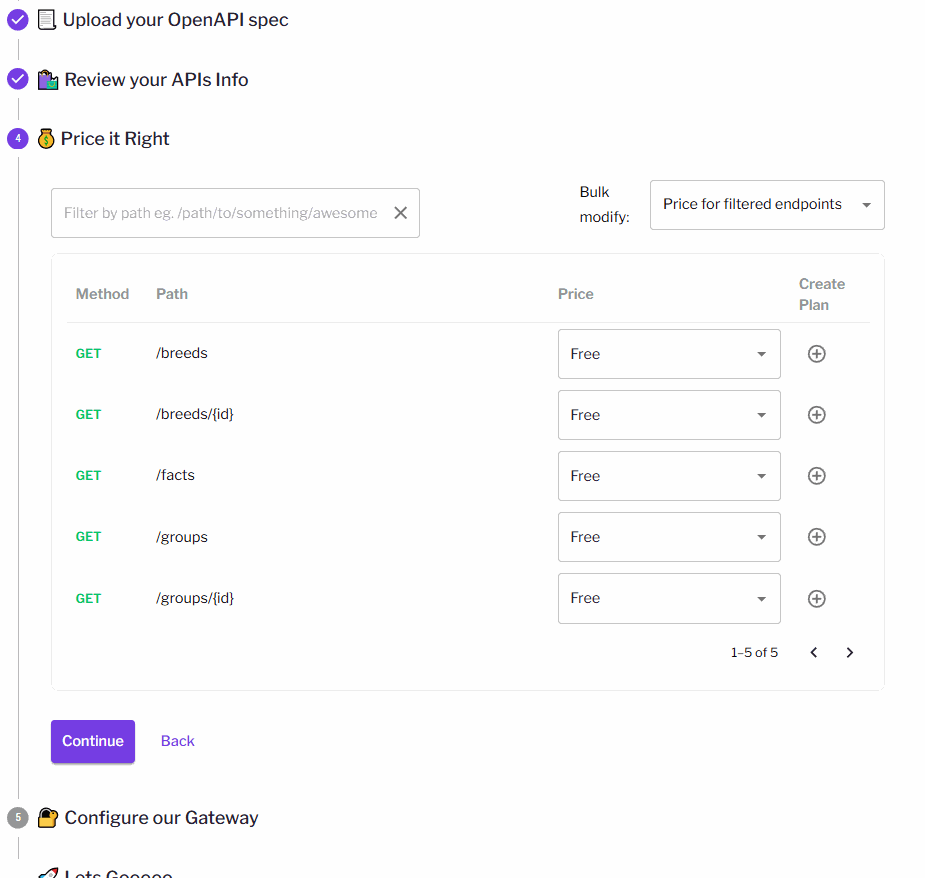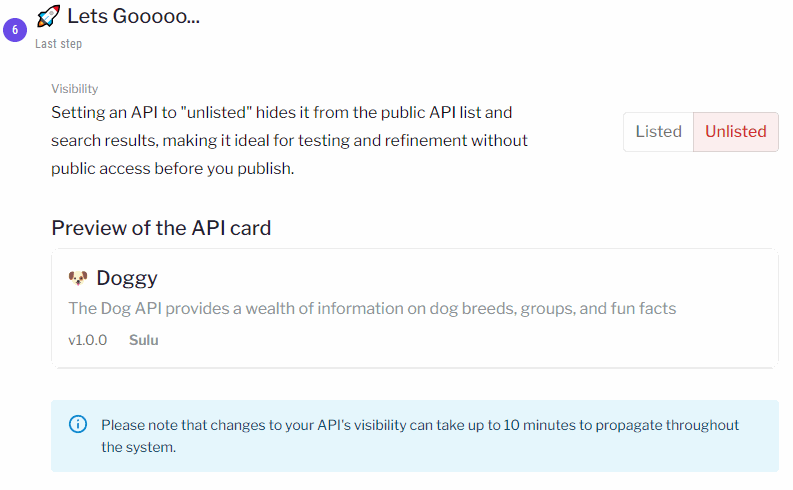Prerequisites
Before you start, make sure you have the following:- An API that you want to publish and that is accessible via HTTP/HTTPS.
- A Sulu account. If you do not have one, you can create one here.
- An OpenAPI specification file. If you do not have one, you can create one using Swagger.
- A README file for your API to introduce it to your users.
- A logo/icon for your API. This will be displayed on the Sulu Hub.
Steps
To follow these steps, you need to be logged in to the Sulu Hub. If you are not logged in, you can do so here.1
2
Pick a Name and Icon
The first step is to provide a name for your API and upload an icon.The name should be unique and descriptive.
It will be displayed on the Sulu Hub and help users identify your API.
It will also be used for search results.The icon will be displayed on the Sulu Hub and API pages.
It can be a very important part of your API’s identity.
3
Upload your OpenAPI Spec
The next step is to upload your OpenAPI specification file.OpenAPI is a specification for building APIs.
It describes the endpoints, request/response formats, and other details of your API
in a human and machine-readable format.It is used by Sulu to generate documentation and to configure your API
in our infrastructure. It can also be used by developers to generate client libraries and other tools.
AI agents can also parse your OpenAPI spec and make calls to your API autonomously.To learn more about OpenAPI, visit the OpenAPI Initiative.To start writing your OpenAPI spec, you can use the Swagger Editor.You can upload the file directly or provide a URL to the file. We accept both YAML and JSON formats.
Things to include in your OpenAPI Spec
- OpenAPI version: 3.0.x or 3.1.x
- Info: Title, Description, Version, Contact, License, Terms of Service.
- Servers: The base URL of your API
- Paths: The endpoints of your API
- Components [optional]: Schemas, Parameters, Responses, Request Bodies, Headers.
Things to avoid in your OpenAPI Spec
- External Component References: External references are not supported by Sulu.
- Security Schemes: Sulu Hub uses its own security scheme to authenticate your API in our proxy layer. You do not need to include security schemes in your OpenAPI spec. Security schemes in your OpenAPI spec will be ignored.
How to make it as useful as possible
- Descriptions: Provide detailed descriptions for each endpoint, parameter, and response.
- Examples: Provide examples for each endpoint, parameter, and response.
- Defaults: Provide default values for parameters. This will help users try the API straight from the documentation.
4
Review you API's Info
The next step is to review the information you have provided so far.
A lot of this information is extracted from the OpenAPI spec provided, but
can be edited here. This information will be displayed on the Sulu Hub.
- Sulu Hostname Prefix: This is the subdomain you choose to access your API through Sulu Hub.
For example, if your API is currently hosted at
api.example.com, your Sulu Hostname Prefix
can be example. In the Sulu Hub, your API will be accessible at example.p.sulu.sh.You can choose whatever you want for your Sulu Hostname Prefix, as long as it is unique in Sulu.- Base URL Suffix: This is the base URL of your API on the Sulu Hub. It is generated from the server URL in your OpenAPI spec. If the path suffix does not look right, we recommend going back to the OpenAPI spec and updating the server URL to avoid confusion, but it can also be edited here.
- API Version: The version of your API. This is extracted from the OpenAPI spec, but can be edited here.
- Short Description: A brief description of your API that is displayed in the API’s card on search results. It should be short and snappy, and give users a quick idea of what your API does. By default, it is the first sentence in the description field of your OpenAPI spec, but can be edited here.
- Long Description: A longer description of your API that is displayed on the API’s page. We recommend up to 3 sentences. For more detailed information, you can use the README. By default, it is the description field of your OpenAPI spec, but can be edited here.
- Terms of Service: A link to the terms of service of your API. This is displayed on the API’s page.
- Website URL: A link to the website of your API. This is displayed on the API’s page.
- Health Check URL: A URL that Sulu will ping periodically to check if your API is up.
- README: A README.md file for your API. This is displayed on the API’s page. It can be written in Markdown and will support all the standard Markdown features. Use this to provide detailed information about your API, including how to use it, examples, features, limitations, and anything else you think is important.
5
Price it Right
In Sulu, every request has a 
price. A price can be fixed or dynamic.
For example, a price can depend on the volume of requests done within a
period. This is called Volume Variable Pricing.A price can be created together with the API being onboarded,
but they are independent objects that can be recycled and linked
to multiple APIs. For more information, checkout the section on Prices.
6
Gateway Configuration
The next step is to configure the gateway for your API.The gateway is the entry point for your API on the Sulu Hub.
It is responsible for routing requests to the correct endpoint,
authenticating users, and enforcing rate limits.You can configure the gateway to use the default settings, or you can customize it
to suit your needs.The gateway configuration includes:
- Upstream Hostname: The original hostname of your API.
For example, if your API is hosted at
api.example.com, the upstream hostname isapi.example.com. - Upstream Protocol: The protocol used by your API. It can be HTTP or HTTPS.
- Upstream Port: The port used by your API. It can be any valid port number. The default port for HTTP is 80, and the default port for HTTPS is 443.
- Request Size Limit: The maximum size of a request that the gateway will accept.
- Proxy Timeout: The maximum time the gateway will wait for a response from your API.
When this time is exceeded, the gateway will return a
504error to the client.
Secrets
If your API requires secrets, such as API keys or tokens, you can add them here. This is specially useful to authenticate your API in the gateway layer. Every time a user makes a request to your API through the Sulu Hub, the gateway will add these secrets to the request. This allows your backend to authenticate the requests coming from our gateway.We support bothheader and query secrets.
They can be added in their respective sections.We automatically generate a X-Suluhub-Secret header that
contains a secret token unique to your API. This token can be used to authenticate requests
coming from the Sulu Hub, but its use is optional.7
Final Step
The final step is to review all the information you have provided and submit your API.Here you can review how you API will look on the Sulu Hub.You can also decide whether to publish it as  We recommend that you first publish your API as
We recommend that you first publish your API as
Listed or Unlisted.
Unlisted APIs are not visible on the Sulu Hub, but can still be accessed by users with the URL.
This is useful for testing or private APIs. We recommend that you first publish your API as
We recommend that you first publish your API as Unlisted to test it and make sure everything is working as expected.
Once you are happy with it, you can change it to Listed to make it visible to the public.APIs, both
Listed and Unlisted, can take up to 10 minutes to propagate through the Sulu Hub infra.
This means that you might have to wait a few minutes before your API is accessible.Fees and Pricing
Publishing your API on the Sulu Hub is free. We do not charge any fees for listing your API. Sulu Hub charges a fee on the revenue generated by your API. We take a 10% cut of revenue. This means that you keep 90% of the revenue. For example, if you set the price for an endpoint at$1, and a user makes a call to that endpoint,
you will keep $0.90, and Sulu will receive $0.10.
This fee is automatically deducted from the revenue when executing a payout.
We do not charge any minimum fees. We only earn money when you earn money.
If your API is free to use, you will not be charged any fees.


